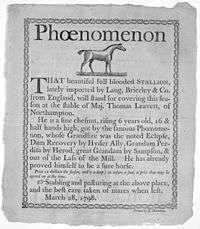Broadside (printing)

A broadside is a large sheet of paper printed on one side only.[1] Historically, broadsides were posters, announcing events or proclamations, or simply advertisements. Today, broadside printing is done by many smaller printers and publishers as a fine art variant, with poems often being available as broadsides, intended to be framed and hung on the wall.
Description and history
The historical type of broadsides were ephemera, i.e., temporary documents created for a specific purpose and intended to be thrown away. They were one of the most common forms of printed material between the sixteenth and nineteenth centuries, particularly in Britain, Ireland and North America. They were often advertisements, but could also be used for news information or proclamations. It was also a very common format for printing the text of ballads (see Broadside (music)).
One classic example of a broadside used for proclamations is the Dunlap broadside, which was the first publication of the United States Declaration of Independence, printed on the night of July 4, 1776 by John Dunlap of Philadelphia in an estimated 200 copies.[2] An example of a broadside used for news information is the first published account of George Washington crossing the Delaware, printed on December 30, 1776 by John Dunlap.[3]
Broadsides were commonly sold at public executions in the United Kingdom in the 18th and 19th centuries. These were often produced by printers who specialised in them. They were typically illustrated by a crude picture of the crime, a portrait of the criminal, or a generic woodcut of a hanging taking place. There would be a written account of the crime and of the trial and often the criminal's confession of guilt. A doggerel verse warning others to not follow the executed person's example, to avoid their fate, was another common feature.[4]
See also
References
- ↑ ILAB: Definition of term: Broadside Retrieved 2011-07-06
- ↑ Illustration for Widmer, Ted, "Looking for Liberty", oped commentary article, The New York Times, July 4, 2008, accessed July 7, 2008
- ↑ Library of Congress - An American Time Capsule, "Congress received the following intelligence..." Retrieved 2011-07-06
- ↑ "Dying Speeches and Bloody Murders: Crime Broadsides Collected by Harvard Law School Library". Harvard University Law School Library. Retrieved March 8, 2013.
Further reading
- A Book of Broadsheets; with an introduction by Geoffrey Dawson. London: Methuen, 1928 ("a reproduction ... of the pocket literature provided by The Times for the men in the trenches during the early days of the War ... every item in it was printed in the autumn of the year 1915 in the form of a broadsheet ..."—p. xi)
External links
- English Broadside Ballad Archive at the University of California, Santa Barbara
- Modern American Poetry Collection at Ball State University Archives and Special Collections Research Center
- Broadsided Contemporary, original broadsides published monthly online and posted around the US and abroad
- Poetry Center of Chicago Broadsides - fine letter press broadsides
- Historical broadsides
- Library of Congress -- Three Centuries of Broadsides and other Printed Ephemera
- University of Georgia - Historical broadsides from 1849-1989
- Wake Forest University - Confederate Broadside Poetry Collection
- 1,800 Scottish broadsides from 1650-1910 at National Library of Scotland
- Broadsides at the Boston Athenaeum
- Crime broadsides
- Historical & Special Collections, Harvard Law School Library; a digitized collection of 500 crime and execution broadsides, from 1707 to 1891.